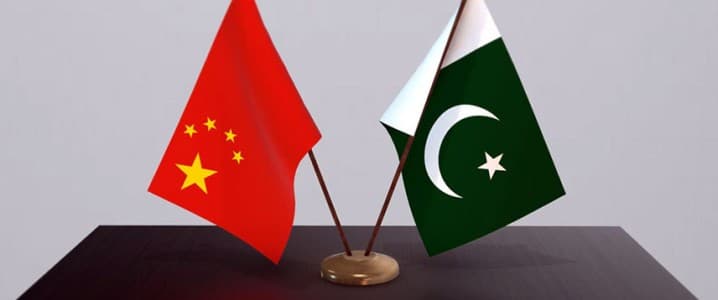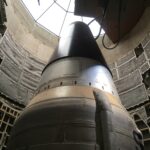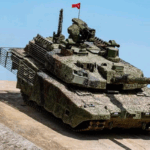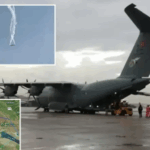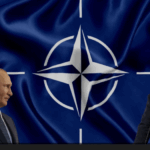Summary by Geopolist | Istanbul Center for Geopolitics:
- China is urging Pakistan to strengthen its security and governance, particularly in areas where Chinese investments are concentrated on the China-Pakistan Economic Corridor (CPEC). The increasing concerns regarding security threats and instability have placed Chinese interests in jeopardy.
- Therefore, this program is a clear and immediate reaction to these concerns. Beijing also prioritizes enhancing Pakistan’s administrative efficiency to ensure the smooth completion of collaborative projects. China’s displeasure is growing due to Pakistan’s inability to ensure the safety of Chinese labourers working on the China-Pakistan Economic Corridor (CPEC), a crucial component of China’s Belt and Road Initiative (BRI). As a result of the adverse circumstances, Pakistan has experienced delays and violence, prompting China to urge Pakistan to improve its security and governance.
- The broader security and governance challenges that Pakistan must address in order to attract foreign investment and ensure the success of initiatives like the CPEC are underscored by China’s concerns.
Pakistan’s stability is a strategic priority for China, as it seeks to protect its economic investments.
Read the full article below.
China Prods Pakistan to Ramp Up Security and Governance
The Communist Party of China is officially atheist but China’s premier, Li Qiang, recently had a “come to Jesus” meeting with Pakistan’s prime minister, Shehbaz Sharif.
China is frustrated by Pakistan’s inability to protect Chinese workers on the $62 billion China-Pakistan Economic Corridor (CPEC), a key part of China’s Belt and Road Initiative (BRI). Aside from killing Chinese citizens, the violence has contributed to CPEC’s slow rollout in a country that needs more electricity, more clean water, more good roads, and, well, more everything, but is “out of friends and out of money,” according to The Economist.
In response to China’s scolding, Pakistan unveiled an anti-terrorism campaign to suppress the Pakistani Taliban, the Tehrik-e Taliban Pakistan (TTP), an ally of the Afghan Taliban and responsible for 700 attacks that killed 1000 people in 2023. The TTP operates partly from Afghan territory so Pakistan will have to attack TTP hideouts on Afghan soil at a time when relations are smarting from Islamabad’s 2023 expulsion of over 540,000 Afghan refugees. (The next phase of the plan may see 800,000 Afghans deported.)
While in China, Sharif met Dr. Wu Fulin, chairman of the Export-Import Bank of China, and promised action to improve governance, increase tax revenue, and ensure ease of doing business to attract foreign direct investment.
In July, Pakistan’s government moved to ban former Prime Minister Imran Khan’s political party, Pakistan Tehreek-e-Insaaf, and file treason charges against Khan one day after he and his wife were acquitted of the charge of “unlawful marriage” and ordered released. The flurry of action against Khan came the same day Reuters reported Pakistan and the International Monetary Fund reached agreement on a $7 billion, 37-month loan program that will require the government to take unpopular measures, such as raising farm income taxes
The establishment’s panicked actions to silence Khan may be meant to signal the situation is under control, but China’s leaders can’t help but observe Islamabad’s preference for public infighting and political payback over good governance and economic development. Khan sought a reset of CPEC in 2018. China and Pakistan’s successfully military pushed back against Khan, but Beijing must be disconcerted by the manic persecution of Khan by Pakistan’s establishment and its hope China will look favorably on the crackdown as a precursor to stability.
Can Pakistan convince the Taliban leadership, split between factions in Kabul and Kandahar, to quell or expel the TTP? Can it offer positive incentives or just threats and attacks that the Taliban will use as justification for counter attacks?
If China slows or pauses its investments with Pakistan until the TTP is less of a threat, what can the neighbors – the Central Asian republics, Afghanistan, and Iran – do to reduce risk to trade and connectivity?
In Central Asia, a key regional initiative is the trans-Afghan railway to connect Central Asia to Pakistan on a route from Termez, Uzbekistan to Mazar-i-Sharif, Afghanistan, thence to Karachi, Pakistan, the UAP railway. The railway will also facilitate the exploitation of Afghanistan’s mineral resources, believed to be worth $1 trillion. The $6.9 billion project will face engineering challenges but a bigger risk is unresolved Taliban-Pakistan tensions. But if Pakistan and the Taliban can’t resolve their dispute, Central Asia has Plan B, the International North-South Transport Corridor (INSTC), a 7200 km multimodal transportation network that links the Indian Ocean to Russia and Northern Europe. In June 2023 the Uzbek and Iranian presidents agreed to increase economic cooperation and trade using Iran’s ports of ports of Chabahar and Bandar Abbas.
The republics can take advantage of the Middle Corridor (AKA Trans-Caspian International Transport Route) which is promoted by the U.S. as a way to isolate Russia, and the newly-commissioned China-Kyrgyzstan-Uzbekistan (CKU) railway, but North-South trade corridors are still necessary and they require involvement by two of Washington’s worst enemies, the Islamic Republic and the Islamic Emirate. The Central Asian republics can also avoid unrest in Pakistan by using the INSTC leg hosted by Iran if the UAP railway stalls.
Related: Texas Faces Growing Electricity Needs
Andrew Korybko notes that partial completion of the UAP railway may still benefit the republics if they can backhaul Afghanistan’s minerals for processing in the republics or in Russia or China. The republics may be able to secure investment for local, sustainable processing of the minerals (with off-take agreements) if Washington and Brussels think that will keep the stuff out of Russian and Chinese hands.
Mineral processing powered by natural gas from Turkmenistan will help Ashgabat diversify away from its reliance on China as an export market as it strengthens the region by helping it climb the value chain.
Trade relations between Uzbekistan and Pakistan have been growing steadily in recent years. In 2022, Pakistan exported goods worth $153 million (M) to Uzbekistan, with the main products being agricultural products and packaged medicaments. Pakistan’s exports to Uzbekistan increased at an annualized rate of 44.5%, from $24.3M in 2017 to $153M in 2022.
Uzbekistan exported goods worth $134 million to Pakistan in 2022, the primary products being mostly agricultural products and cotton yarn. Uzbekistan’s exports to Pakistan grew at an annualized rate of 69.7%, from $9.53M in 2017 to $134M in 2022.
Both countries are working to further strengthen economic ties, with Pakistan aiming to facilitate Central Asian states’ access to the Arabian Sea via the port of Karachi via the 760-kilometer UAP railway. The countries plan cooperation beyond trade to include fields such as tourism, education, health care, and energy projects.
In February 2023, Kazakhstan and Pakistan signed a transit trade agreement and the sides are considering an agreement between the State Bank of Pakistan and the National Bank of Kazakhstan to encourage cooperation in the banking sector. In June 2024, Kazakhstan invited Pakistan to join the first North-South Transport Corridor forum in Aktau.
Trade between the countries has grown significantly in recent years. In 2022, Pakistan exported $95.5M to Kazakhstan, mostly agricultural products. Over five years Pakistan’s exports to Kazakhstan increased at an annualized rate of 12.7%, from $52.5M in 2017 to $95.5M in 2022.
Kazakhstan exported $45.9M to Pakistan in 2022. The main exports were iron products and fertilizer. Over five years the exports of Kazakhstan to Pakistan grew at an annualized rate of 43.3% from $7.59M in 2017 to $45.9M in 2022.
Since July 2023, a direct air corridor has been established between Pakistan and Kazakhstan, and in August 2024 the countries announced the Trans-Afghan Multimodal Transport Corridor, from Kazakhstan via Uzbekistan, Afghanistan, and Pakistan, and onward by sea to the port of Jebel Ali, United Arab Emirates, a journey of 20-25 days.
Trade between Pakistan and Turkmenistan is negligible. In 2022, Pakistan exported $1.27M to Turkmenistan, the major item being soap. Over five years the exports of Pakistan to Turkmenistan decreased at an annualized rate of 17%, from $3.23M in 2017 to $1.27M in 2022.
Exports from Turkmenistan were slightly better at $8.77 million in 2022, mostly sheep hides and cotton products. Over five years the exports of Turkmenistan to Pakistan dropped at an annualized rate of 11.5%, from $16.2M in 2017 to $8.77M in 2022.
Despite that low base, the countries want to trade more, and in April 2024 they announced a transit trade agreement and possible export of electricity from Turkmenistan and cooperation in the energy field. In July 2024, in the third round of bilateral political consultations, the sides agreed to liberalize visa policies for businessmen, and to implement projects such as the much-delayed Turkmenistan–Afghanistan–Pakistan–India (TAPI) natural gas pipeline (which may compete with the Iran-Pakistan natural gas pipeline which is also stalled, though due to U.S. sanctions), power transmission lines, information technology, and fiber-optic communications. Pakistan offered use of the Gwadar and Karachi seaports for onward shipment of goods.
Trade relations between Iran and Pakistan have been evolving positively. During Iranian President Ebrahim Raisi’s April 2024 visit to Pakistan, both countries agreed to soon finalize a Free Trade Agreement to strengthen economic cooperation and boost their bilateral trade to $10 billion over the next five years. Additionally, both sides agreed to facilitate the regular exchange of economic and technical experts and delegations from Chambers of Commerce to boost economic cooperation.
In 2022, Iran exported $762M to Pakistan. The main products were petroleum gas, electricity, and petroleum coke. Over five years the exports of Iran to Pakistan decreased at an annualized rate of 2.12%, from $848M in 2017 to $762M in 2022.
Pakistan’s exports to Iran are negligible, amounting to $22, 300 to Iran, the main products being iron pipes, medical instruments, and utility meters. Over five years exports of Pakistan to Iran decreased sharply at an annualized rate of 83.1%, from $162M in 2017 to $22.3k in 2022. It remains to be seen how bilateral trade will reach $10 billion when Pakistan’s exports are currently equal to the price of a used automobile.
Trade between Afghanistan and Pakistan has remained healthy despite Islamabad’s dismay that the Taliban are no longer taking direction, especially regarding suppressing cross-border attacks by the Tehrik-e Taliban Pakistan which has sanctuaries in Afghanistan.
In 2022, Pakistan exported $975M to Afghanistan, the main products being rice, packaged medicaments, and vegetable oils. Over 5 years exports of Pakistan to Afghanistan decreased at an annualized rate of 13.4%, from $2B in 2017 to $975M in 2022.
Conversely, Afghanistan exported $847M to Pakistan, the main products being coal briquettes, raw cotton, and grapes. Over 5 years exports of Afghanistan to Pakistan increased at an annualized rate of 11.5%, from $440M in 2017 to $847M in 2022.
Despite the cross-border tensions which haven’t abated after the departure of U.S. troops in August 2021, Afghanistan reopened the Torkham border crossing in February 2023, and in May 2023 the respective foreign ministers pledged further cooperation in bilateral trade and cross-border security.
As Pakistan is scrambling to set things right with China, Russia may be moving to normalize relations with the Taliban. In June, a Taliban delegation attended the St. Petersburg International Economic Forum, and in July Russia’s envoy to the United Nations hinted Moscow could drop sanctions on the Taliban.
China is also edging up to normalized relations with the Taliban: In December 2023, Beijing accepted the credentials of the Taliban ambassador, and China’s ambassador to the Islamic Emirate reported for duty in September 2023. And while it is definitely a stretch goal, in October 2023 the Taliban announced it wants Afghanistan to join China’s BRI.
Perhaps anticipating Moscow’s action, in May the Taliban announced a logistics and energy trading hub at Herat in the country’s northwest to facilitate oil sales from Russia to South Asia. The project will be in cooperation with Kazakhstan and Turkmenistan, which highlights the republics’ approach to Kabul: Kazakhstan removed the Taliban from its terrorist list in December 2023, and Uzbekistan never declared the Taliban an extremist group and in 2018 publicly encouraged the Taliban to start negotiations with the Islamic Republic. Turkmenistan was mum on the topic of the Taliban in line with its policy of permanent neutrality.
Iran’s new president, Masoud Pezeshkian, published “My message to the new world” to explain his policies that include championing the establishment of a “strong region“ to include not just the states that border Iran but also Türkiye and the Arab states of the Persian Gulf. Pezeshkian’s policy is a continuation Tehran’s 2005 “Look East” policy that formalized increasingly close ties to Beijing and Moscow and was formulated before the China-brokered rapprochement with Saudi Arabia.
Pezeshkian also noted the importance of working with the neighbors on water management, counter-smuggling, and transport corridors. Iran is a big country in terms of geography and population, but Pezeshkian apparently wants to be a good neighbor and to stand in contrast to Pakistan where corruption and political retribution preoccupy the ruling class and thus stifle economic growth.
Pezeshkian’s letter noted the Iran-China “25-year roadmap” that would see up to $400 billion of Chinese investments in Iran’s “infrastructure, energy, science, and technology projects.” Iran recently inked a 20-year agreement with Russia, largely for cooperation in the defense and energy sectors. Notably, the agreement gives Russia the right of first extraction in the Iranian section of the Caspian Sea and Iran’s major oil and gas fields in the provinces bordering Iraq.
Though Iran is not officially in CPEC it can attract more Chinese interest by being not Pakistan and allowing China to come to the obvious conclusion. More Chinese participation in Iran will give Beijing another avenue into Afghanistan and Central Asia.
When China planned a westbound land corridor to counter American plans to isolate it in the event of a conflict over Taiwan, it had no choice of routes: Afghanistan was at war, and occupied by NATO troops; the Central Asian republics were heavily influenced by the U.S. which used the region as a platform for its attempted pacification of Afghanistan; and, a Russian route would pose unacceptable risk if relations soured or the Americans were able to drive a wedge between Moscow and Beijing.
Pakistan yearns to be recognized as a leader in the region and can earn it by making the painful (for the ruling class, that is) changes China demands. The country’s leaders have focused on rent-seeking during the Cold War, the Soviet war in Afghanistan, and the 2001-2021 U.S.-NATO occupation of Afghanistan, and failed to leverage the country’s strategic location for development and future advantage as was done by the leaders in Singapore and the United Arab Emirates.
If Pakistan doesn’t improve governance, as Prime Minister Sharif promised Dr. Wu in June, the hoped-for economic growth won’t materialize. And while Pakistan’s neighbors have alternate transport routes to world markets via the INSTC and the Middle Corridor, the loss of local trade will erode Islamabad’s position as Moscow (friendly with India) and Beijing (getting friendlier with India) secure additional economic opportunities on its border.
By James Durso
Source: Oil Price

